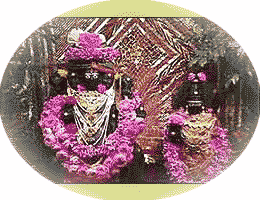
Gudi Padwa, also known as Ugadi, is celebrated on the first day of the Hindu month of Chaitra, which according to the Gregorian calendar would fall sometime at the end of March and the beginning of April. This festival is supposed to mark the beginning of 'Vasant' or spring. According to the 'Brahma Purana', this is the day on which Brahma created the world after the deluge and time began to tick from this day forth.
India was, and still is to a certain extent, a predominantly agrarian society. Thus, celebrations and festivals were often linked to the turn of the season and to the sowing and reaping of crops. There is a theory that the word 'padwa' might have its roots in the Sanskrit word for crop, which is 'Pradurbhu.' The word 'padwa' as used contemporarily means 'New Year', but this day also marks the end of one harvest and the beginning of a new one, which for an agricultural community would signify the beginning of a New Year. In the case of Gudi Padwa, it is celebrated at the end of the Rabi season. The term 'padava' or 'padavo' is also associated with Dipawali, another New Year celebration that comes at the end of the harvesting season, thus substantiating the agricultural link to the festival.
The festivities
On the festive day, courtyards in village houses will be swept clean and plastered with fresh cowdung. Even in the city, people take the time out to do some spring cleaning. Women and children work on intricate rangoli designs on their doorsteps, the vibrant colours mirroring the burst of colour associated with spring. Everyone dresses up in new clothes and it is a time for family gatherings. Specialities like soonth panak and chana usal are eaten on this day.
Traditionally, families are supposed to begin the festivities by eating the bittersweet leaves of the neem tree. Sometimes, a paste of neem leaves is prepared and mixed with ajwain, gul, tamarind and jaggery. All the members of the family consume this paste, which is believed to purify the blood and strengthen the body's immune system against diseases.
The 'gudi'
While the 'padwa' part has been explained, you're probably wondering what a 'gudi' is. A 'gudi' is a pole on top of which an upturned brass or silver pot called a kalash is placed. The gudi is covered with a colourful silk cloth and decorated with coconuts, marigolds and mango leaves that symbolize nature's bounty. On Gudi Padwa, you will find gudis hanging out of windows or otherwise prominently displayed in traditional Maharashtrian households.
Ugadi is the New Year's Day for the people of Andhra Pradesh/Karnataka . Those who live north of the Vindhya hills observe it as "Barhaspatyamana". People living to the south of the Vindhya hills observe it as "Sauramana" or "Chandramana".
No comments:
Post a Comment